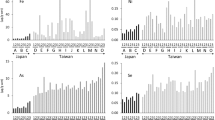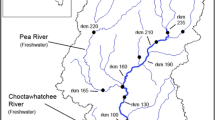Abstract
The authenticity of dried shark fins was identified using stable carbon and nitrogen isotopic compositions, chemical structure, and morphology characterization by means of element analyzer-isotope ratio mass spectrometry (EA-IRMS), attenuated total reflection-Fourier transform infrared spectroscopy (ATR-FTIR) analysis, and scanning electron microscope (SEM) characterization of samples. The results indicated that real dried shark fins, fake dried shark fins, and artificial dried shark fins could be easily distinguished from each other. δ 13C values of real dried shark fins, fake dried shark fins, and artificial dried shark fins were −14.231 ± 1.204‰, −17.247 ± 0.621‰, and −14.561 ± 1.016‰, respectively, and highly significant (P < 0.01) within real dried shark fins and fake dried shark fins. On the other hand, δ 15N values of artificial dried shark fins (6.860 ± 0.519‰) and real dried shark fins (13.501 ± 2.421‰) presented significant differences (P < 0.01). Considering the obvious differences of these samples with ATR-FTIR and SEM analysis, the combination of IRMS with ATR-FTIR and SEM technique has the advantage over traditional identification method to be relatively good in accuracy and applicability. Thus, these techniques could potentially be useful for dried shark fin identification.


Similar content being viewed by others
References
Aranishi F, Okimoto T, Izumi S (2005) Identification of gadoid species (Pisces, Gadidae) by PCR-RFLP analysis. J Appl Genet 46:69–73
Blanco M, Pérez-Martín RI, Sotelo CG (2008) Identification of shark species in seafood products by forensically informative nucleotide sequencing (FINS). J Agric Food Chem 56:9868–9874
Cabañero AI, Recio JL, Rupérez M (2006) Liquid chromatography coupled to isotope ratio mass spectrometry: a new perspective on honey adulteration detection. J Agric Food Chem 54:9719–9727
Clarke SC, Magnussen JE, Abercrombie DL, McAllister MK, Shivji MS (2006a) Identification of shark species composition and proportion in the Hong Kong shark fin market based on molecular genetics and trade records. Conserv Biol 20:201–211
Clarke SC et al (2006b) Global estimates of shark catches using trade records from commercial markets. Ecol Lett 9:1115–1126
Clarke S, Milner-Gulland EJ, Cemare TB (2007) Social, economic, and regulatory drivers of the shark fin trade. Mar Resour Econ 22:305–327
Deepthi N, Zofia B, Debra LA, Demian DC, Chad RH, Nicholas SF (2014) Methylmercury in dried shark fins and shark fin soup from American restaurants. Sci Total Environ 496:644–648
Fabrice T, Celia M, Catherine H (2005) Food and forensic molecular identification: update and challenges. Trends Biotechnol 23:359–366
Han W, Luo H, Xian Y, Luo D, Mu T, Guo X (2015) Attenuated total reflection-Fourier transform infrared spectroscopic study of dried shark fin products. Spectrosc Spectr Anal 35:379–383
Holmes BH, Steinke D, Ward RD (2009) Identification of shark and ray fins using DNA barcoding. Fish Res 95:280–288
Kiyo M, Neil H, Margaret B, John P, Sandra AB, Deborah CM (2012) Cyanobacterial neurotoxin β-N-Methylamino-L-alanine (BMAA) in shark fins. Mar Drugs 10:509–520
Li GC, Wu ZJ, Wang YH, Dong XC, Li B, He WD, Wang SC, Cui JH (2011) Identification of geographical origins of Schisandra fruits in China based on stable carbon isotope ratio analysis. Eur Food Res Technol 232:797–802
Magnussen JE, Pikitch EK, Clarke SC, Nicholson C, Hoelzel AR, Shivji MS (2007) Genetic tracking of basking shark products in international trade. Anim Conserv 10:199–207
Rima WJ, Saif MAG, Waleed H, Aaron CH, Julia LYS, Mahmood SS, Robert HH (2015) The trade in sharks and their products in the United Arab Emirates. Biol Conserv 181:190–198
Woolfe M, Primrose S (2004) Food forensics: using DNA technology to combat misdescription and fraud. Trends Biotechnol 22:222–226
Xian Y, Dong H, Luo H, Luo D, Wu Y, Zhao M, Guo X (2015) Identification of dried shark fins by analysis of seven sugars using pre-column derivatization highperformance liquid chromatography and stable carbon isotope ratio analysis. Anal Methods 7:5973–5980
Yancy HF et al (2008) Potential use of DNA barcodes in regulatory science: applications of the Regulatory Fish Encyclopedia. J Food Prot 71:210–217
Acknowledgments
This work was supported by science and technology planning project of General Administration of Quality Supervision of China (2013QK278) and the National Natural Science Foundation of China (31371842). At the same time, the authors would like to thank all the workers for sampling, sample preparation, and measurement.
Author information
Authors and Affiliations
Corresponding author
Ethics declarations
Conflict of Interest
Donghui Luo declares that he has no conflict of interest. Hao Dong declares that he has no conflict of interest. Yanping Xian declares that she has no conflict of interest. Yuluan Wu declares that she has no conflict of interest. Xiaofang Zeng declares that he has no conflict of interest.
Ethical Approval
This article does not contain any studies with human participants or animals performed by any of the authors.
Informed Consent
Informed consent was obtained from all individual participants included in the study.
Rights and permissions
About this article
Cite this article
Luo, D., Dong, H., Xian, Y. et al. Stable Isotope Ratios Combined with Fourier Transform Infrared Spectroscopy and Scanning Electron Microscope Analysis to Identify the Dried Shark Fins. Food Anal. Methods 9, 2400–2405 (2016). https://doi.org/10.1007/s12161-016-0424-7
Received:
Accepted:
Published:
Issue Date:
DOI: https://doi.org/10.1007/s12161-016-0424-7




